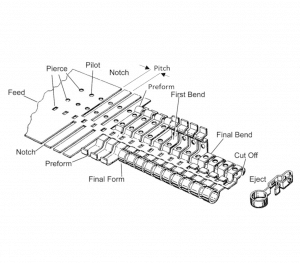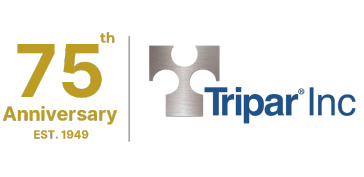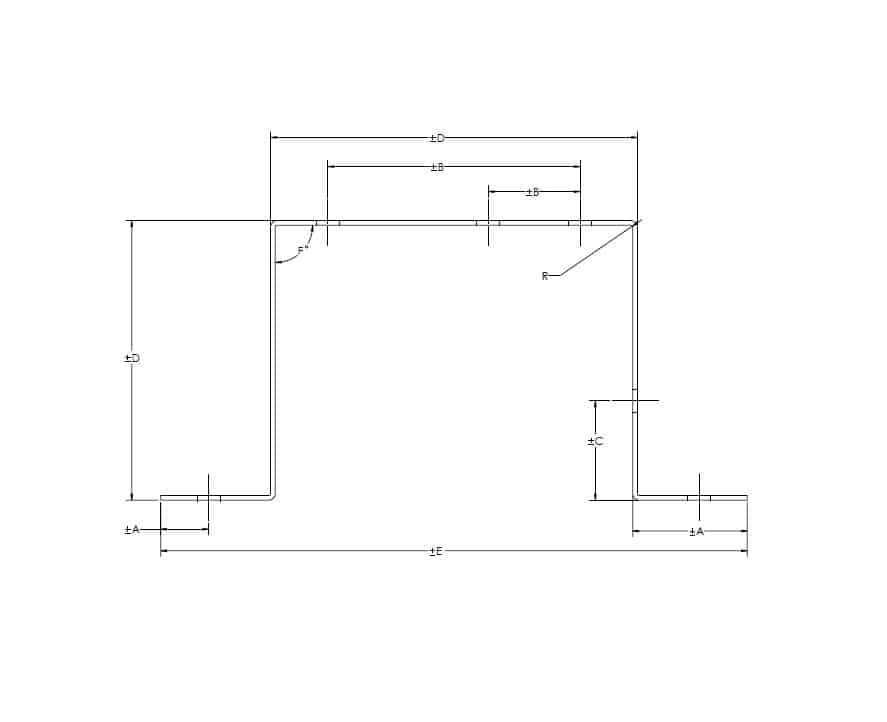Overview
Progressive die stamping is a sheet metal forming process widely used to produce parts for a variety of industries. Progressive dies contain individual work stations, each of which performs one or more different operations on the part, such as piercing, blanking, coining bending, forming, and even drawing. The precision components within the progressive die are mounted within what is known as a die set (a heavy steel upper and lower plate with precision guide pins to align the two plates), which is placed into a reciprocating stamping press. As the press moves up, the upper die half moves with it, allowing the material to feed or advance with each stroke. When the press moves down, the die closes and performs the stamping operation, simultaneously at all work stations.

A feeder or feeding system typically pushes a strip of metal (usually from a coil) through all of the stations of a progressive stamping die at a specific distance or “pitch”, which is a constant distance between each station within the die. As the strip is pushed through the die, each station performs a specific operation. As the strip progresses, an increasing number of features become inherent within the part. The final station is a cutoff operation, which separates the finished part from the strip or carrying web. With each stroke of the press, a completed part is removed from the die. The carrying web, along with metal that is punched away in previous operations, becomes scrap metal. Both are either knocked through or cut away from the die, and then ejected from the die set.
Since additional work is progressively done in each “station” of the die, it is important that the strip be advanced very precisely so that it aligns within a few thousandths of an inch as it moves from station to station. Tapered or conical “pilots” enter previously pierced holes in the strip to ensure this alignment, since the feeding mechanism alone cannot usually provide the necessary precision in feed length.
The high precision die components (die blocks, punches, cams, etc.) are usually made of heat-treated tool steel to withstand the high shock loads, to retain a sharp cutting edge, and to resist the associated abrasive forces.
Financial Considerations
Progressive dies costs are determined by part’s complexity, the number of features, and the complexity of each feature. Minimizing and simplifying all of these aspects within the part, will keep tooling, or die costs to a minimum. Features that are small, narrow, or close together can be come problematic because there may not be sufficient clearance, requiring additional die stations, all of which drives progressive die costs.
Progressive die costs range from under $10,000, to upwards of hundreds of thousands of dollars, and are most dependent on part size and complexity. Justification for a progressive die is almost always dictated by part quantity. Given sufficient volume, progressive die stamping may be justified as the process leads to the lowest part cost, largely due to high production rates, thus relatively low labour cost per part, and often no secondary operations.
Alternatives
Alternatives to progressive die stamping include;
- CNC Punch, laser, and other metal fabrication techniques: These require little or no tooling, thus are ideal for lower part volumes. However, because of increased material and part manipulation, operations, and labour, part cost will invariably be higher.
- Partial Progressive: This is where some of the part features are produced in a progressive die, but the most
complex features, or those which have multiple variants, are produced either in a secondary (and lower
cost) die, or finished or customized using CNC metal fabrication techniques.
Progressive die stamping is explained in the following Tripar video:
![]() Please click here to watch more Tripar’s videos on our YouTube channel.
Please click here to watch more Tripar’s videos on our YouTube channel.
Conclusions
In conclusion, unless part quantities are exceptionally high (where a progressive die is likely the best solution), or exceptionally low (where a non-tooled solution may be warranted), a cost/benefit analysis must be performed to assess the short to long term costs at different volumes using each process. Working with a reputable metal stamper/fabricator that offers multiple processes & solutions will help determine the optimal solution for you.
For more information please contact TriparTech@triparInc.com.



